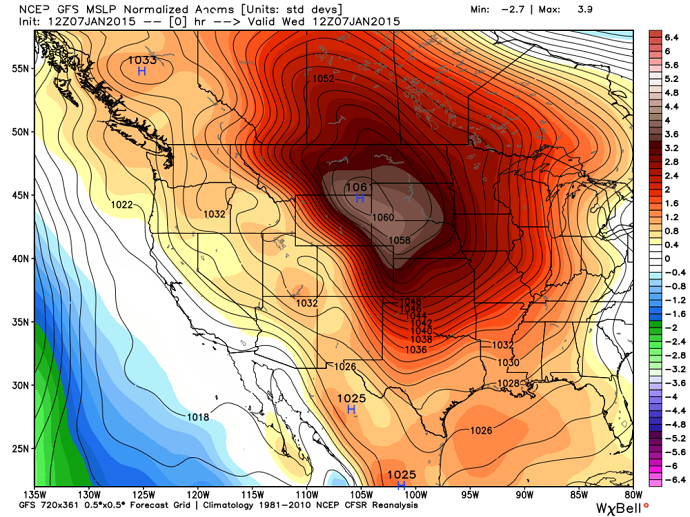Polar vortex is so 2013: High pressure will dominate this winter season
Meteorologist
Wednesday, January 7, 2015, 3:40 PM - Move over polar vortex, as high pressure will reign supreme this winter season. At first, 'atmospheric river' was poised to take over as the 2014-2015 winter buzzword with the flooding rains in California and British Columbia.
Typically, these events overshadow your household barometer, but quietly hanging on the wall, it's discretely flexing its muscles (needle) to uncharted territories.
The large zit-like feature below shows the likelihood that the atmospheric pressure (pressure caused by the weight of the atmosphere) will exceed 1050.0 hPa — a respectable pressure indeed.
These values are currently verifying Wednesday morning.
How abnormal is this?

Another common measure to see if a certain weather parameter is falling out of range is standard deviation (a measure of the variation from the mean) — most observations tend to fall within two standard deviations (~95 percent of observations).

In fact, this high pressure system is pushing barometers across this nation to new frontiers rarely measured before in Canada and the United States, as weather nerds are tracking the powerful pressure readings throughout the nation.
This isn't the first case of anomalous high pressure, as just last week Seattle recorded their highest barometric pressure (atmospheric pressure) of all-time at 1045.5 hPa!
Q: Can you perceive this difference, though?
A: Likely not.
Ever since we were born we've been subjected to an astounding 1 kilogram per square cm of pressure being applied to our skin.
In psychology, this is called a difference threshold; or the minimum amount of stimulus intensity change needed to produce a noticeable change. Typically, we need to change elevation at a faster rate, or climb a mountain before we can often perceive the elevation changes — we'll often notice these changes with air travel, specifically during takeoff and landing.
*pop*
Another common term is the just-noticeable difference (JND) where 50 percent of subjects perceive a change, giving you the curve below:

But even with the extreme swing in pressure, on the grand scale it is a relatively small adjustment. The added "weight" of the air from the increased pressure you'd feel is about 1/2 pound per square inch (normal pressure is 14.7 pounds/square inch (psi) and today it's about 15.2 psi), or the same as being under about 14 inches of water in a pool during average air pressure days. - Meteorologist Scott Sistek
In metric units the added pressure applied on your body is roughly the equivalent of submersing yourself in a bathtub to a depth of between 30-40 centimetres.
Hardly noticeable.



